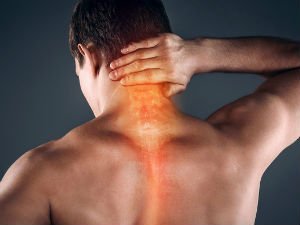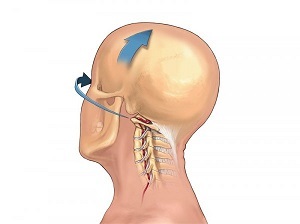
Osteochondrosis of the neck is a common spinal disease that affects patients of all ages.
Represents degenerative changes in the vertebral disc, taking place against the background of severe stress, wearing the wrong shoes, severe physical exertion and malnutrition. It develops gradually, so that the patient may not immediately notice the first symptoms.
Main signs of the disease
Symptoms of cervical osteochondrosis appear as the pathology progresses. They are most noticeable during a deterioration. Once you notice the first signs of the disease, it is recommended to consult a doctor, as it is often disguised as other disorders, which complicates the timely diagnosis.
Patients usually contact the following complaints:
- Severe pain in the collar area.
- Noise and choking in the ear.
- Frequent dizziness.
- Shortness of breath, feeling short of breath.
- Nausea, vomiting.
- Blood pressure drops. Frequent paleness or syncope.
- Increase in body temperature.
Signs of cervical osteochondrosis in men do not differ much from those seen in women. Patients complain of discomfort in the neck, sternum and shoulder girdle. You should contact your local therapist or neurologist for a diagnosis.
Neck pain
One of the most common symptoms of cervical spine chondrosis is neck pain that affects the back of the head and shoulders. The nature of the pain (sharp, mild pain) depends directly on the site of the wound and the severity of the development of the pathological process. In the initial stage, this can be a slight inconvenience, which does not allow you to freely turn your head in all directions. Gradually the pain becomes chronic and limits the range of motion.
Pain occurs as a result of deformity of the vertebrae, due to insufficient blood supply to the collar area. Against the background of this process, spasms, anxiety attacks and panic are observed. A painful sensation in the neck area may radiate to the shoulders or arms. Growth after sleep, sudden movements, laughter or sneezing. Discomfort is combined with a characteristic seizure when trying to turn or muscle weakness.
Muscle spasm and poor circulation often lead not only to pain but also to temporary loss of the ability to move the neck. Persistent overload spreads throughout the head and the patient begins to complain of migraine attacks.
tinnitus and stuffy earsOsteochondrosis in the neck area is also manifested by a feeling of suffocation in the ear, hearing loss and noise. All this is due to insufficient intensity of blood flow to the vestibular apparatus. This complex of symptoms is called cochlear, but doctors rarely associate it with a vertebral disorder. Pay attention to the nature of the noise and tinnitus, they usually intensify when a person is in a position for a long time or tries to change it.
Patients with hearing problems refer to an otolaryngologist. In the presence of concomitant disorders of the condition, such as numbness of the face, limited mobility of the neck, additional consultation with a neurologist is required to clarify the diagnosis and determine the cause.
Headaches and migraines
The main symptoms of cervical osteochondrosis in men are rarely associated with frequent headaches, the female population is more susceptible to them. The vertebrae in this area are constantly exposed to excessive stress, which leads to their gradual deformation if the muscle tissues are not elastic enough to keep them in a natural position. More is more difficult to identify the cause of the headache, as the symptoms are not specific.
The following reasons provoke an attack:
- Spasm of cerebral vessels.
- Compressed nerve endings in the cervicothoracic spine.
- Increased blood pressure.
- Acute venous outflow violation.
- Increased fatigue.
- Prolonged stay in an unnatural position.
Headache worsens during an exacerbation and in a patient, including a male. By nature, it can be constant, dull in the form of seizures or pulsating. In older people, this symptom requires close attention, as it may indicate an initial stroke, angina pectoris, heart attack or hypertension. Therefore, first of all, these conditions are ruled out before starting treatment for osteochondrosis.
With heart pathologies, patients also complain of compression in the chest area, an irregular heartbeat that allows the doctor to differentiate the condition in time. Headaches accompanied by nausea, shortness of breath, necessarily require ECG.
Dizziness
Impaired coordination and frequent dizziness often occur when osteochondrosis develops in grade 2 or more. This is due to degenerative changes in the vertebrae, spasms, stuck nerve endings. The brain does not receive the required amount of oxygen, which negatively affects the functioning of the vestibular apparatus.As a result of state deviation, the symptom is:
- Systemic vertigo.They appear as a sensation of rotation of the whole body and surrounding objects. Dysfunction occurs due to dysfunction of the vestibular apparatus, weakening of muscle tissue and receptors located in the joints.
- Unsystematic vertigo.In addition to instability, patients experience mixed periods, an unstable state in a vertical position. Circular rotation is usually absent.
Dizziness is a serious symptom that should be treated immediately by a doctor. In the presence of numbness in the shoulders, paralysis of the facial muscle tissue, loss of consciousness, urgent hospitalization are required.
Shortness of breath and shortness of breath
Another serious symptom of advanced osteochondrosis in the shoulder area is a persistent feeling of shortness of breath. Respiratory problems arise from the compression of nerve endings and receptors that do not transmit impulses from the pharynx to the esophagus. Shortness of breath occurs when the vertebrae shift, it grows into a stressful state, accompanied by a lump in the throat. After taking a sedative, the health condition returns to normal.
Shortness of breath provokes radicular syndrome. Diaphragm spasm affects the depth and rhythm of respiration. The patient becomes stuffy and has difficulty breathing air, problems with memory and concentration appear. Such a symptom in osteochondrosis requires immediate help, as it can cause a number of serious complications. The doctor chooses the drug individually, taking into account the condition.
Mixed
There is a large collection of nerve endings in the cervical region, where an artery flows, which is responsible for transporting nutrients to the brain. With osteochondrosis, extensions and intervertebral hernias gradually form, which affect blood pressure, and as a result, the patient feels a mixed attack.
Prolonged impairment of normal circulation leads to vomiting, loss of consciousness and causes stroke and disability. Therefore, the appearance of such symptoms, which is not accompanied by nutritional errors, requires immediate medical advice.
Increased blood pressure
For cervical osteochondrosis, a typical symptom is a pressure jump during the day. For a long time, increased or decreased blood pressure is not maintained, which is a characteristic sign of degenerative changes in the intervertebral disc. The daily dynamics of blood pressure is spasmodic, as irritation of nerve endings is reflex and causes short-term vascular spasms.
A distinguishing feature of increased pressure in cervical osteochondrosis is:
- headache;
- chest discomfort;
- reduces sensitivity in the collar area;
- Muscle tension after being in a position for a long time.
All of this is taken into account when making a diagnosis. Rapid deterioration of the condition and sudden changes in pressure are the basis for hospitalization of the patient and his provision of assistance in a hospital setting.
Damage to vision
Osteochondrosis of the cervical spine often provokes such unpleasant symptoms as double vision, tremors, the appearance of "flies". This signals the severity of the process and requires a visit to a doctor.
Against the background of the destruction of connective tissue in the vertebrae, the following diseases may develop:
Glaucoma- The patient is diagnosed with increased intraocular pressure, optic nerve damage. It is impossible to completely eliminate pathologists, only to achieve lasting remission with complex treatment.
- Cataracts.This pathological process leads to the destruction of the lens. The changes are associated with metabolic processes and acute impairment of oxygen supply to the brain. The first sign of the disease is the appearance of "flies" before the eyes. Timely initiation of treatment helps maintain the patient's vision. Claude Bernard-Horner's disease. Hypoxia in the occipital region is considered one of the causes of the lesion. The main signs of a pathological condition are a decrease in the pup's reaction or a change in the pup's size in different eyes. Some patients complain that they can not completely close their eyes for a night's rest, and twilight vision also suffers.
The ophthalmologist prescribes treatment after a thorough examination. But therapy is performed only in a complex aimed at eliminating the cause of the violation. Only then can the problem be effectively addressed.
Pharyngeal problemsDegenerative changes in the cervical vertebrae provoke swallowing problems. The patient complains of a lump in the throat, sweating, sensation of a foreign body in the throat, itching. Signs indicate a dysfunction of the neurovascular trunks emerging from the spinal cord. But the symptomatology is not considered characteristic and can be observed with pathological disorders such as inflammation, swelling.
Change in body temperature

Osteochondrosis, as it progresses, causes an increase in body temperature. This symptomatology occurs when the vertebral artery is damaged, spinal canal stenosis or disc protrusion. Provokes changes in neurosis and concomitant neurological disorders.
Against the background of a rise in temperature, there is numbness of the tongue or hands, an inflammatory process in the lymph nodes, a burning sensation of the tongue.
The characteristic chewing when turning the neck allows osteochondrosis to be suspected.
Symptoms of stage-dependent osteochondrosis Signs of osteochondrosis of the cervical spine depend mainly on the stage of development of the pathology, the compressive strength of the nerve endings and the process of deformation of the disc. Provokes the appearance of symptoms of vertebral artery compression and a violation of blood flow to the brain. Stuck nerve endings lead to severe neurological pathologies.The severity of the symptoms depends directly on the stage of the disease:
- Beginners.Degenerative processes in the vertebral discs take place unnoticed by the patient. Quite it is quite difficult to notice the first changes, as these can be mild headaches (more felt in women), neck discomfort, slight deterioration of vision or loss of sensation in the collar area. At this stage, patients rarely go to the doctor, attributing the symptoms to fatigue, lack of sleep or stress.
- The second phase.As the pathology progresses and disc elongation appears, more pronounced symptoms appear. The destruction of ring fibrosis affects the movements of the head, they become more restricted. Also, patients begin to complain of persistent tinnitus, impaired visual function, neck pain with a characteristic seizure, swallowing problems, sleep disturbance, and decreased reflex clarity. Holding the head in one position causes severe discomfort, which requires consultation with the doctor.
- The third phase. Gradually, intervertebral hernias form, the fibrous ring is completely destroyed, there is deformation of the vertebrae, displacement of bone segments, displacement, instability. The patient complains of acute neck pain, pronounced shoulder syndrome, paralysis of the upper limbs, no tendon reflexes, impaired sensitivity of the scalp. This is a severe stage of the disease that requires complex treatment.
Age directly affects the severity of symptoms. The older the patient, the stronger the changes in connective and bone tissue. This is due to the weakness of muscle fibers, nutritional deficiencies and chronic inflammatory diseases in the body.
Patient Reviews
Osteochondrosis of the cervical vertebrae is a common disease, as the nerve roots are constantly exposed to stress due to excessive segment movement. Timely detection of pathology avoids serious complications, so many people read patient reviews and compare them to their symptoms.
is strictly forbidden to diagnose yourself without laboratory tests and apparatus. Any information should be taken as a note only.
Osteochondrosis of the cervix is manifested by a large number of symptoms, but most of them are easily confused with similar pathologies. Therefore, it is recommended to consider the patient's complaints in a complex and perform differential diagnosis, which allows timely identification of the disease and description of correct treatment, which includes physiotherapy, gymnastics and medication treatment.











































